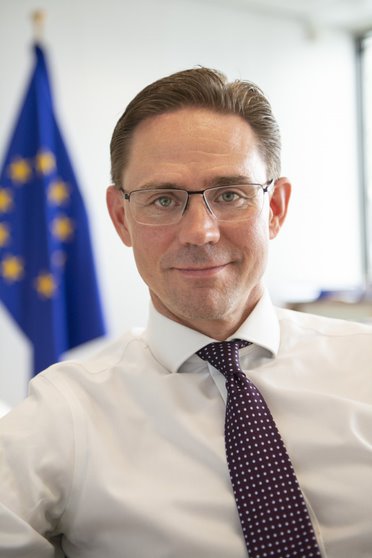The future of jobs
In the third issue of In Focus magazine, Jyrki Katainen, European Commission Vice-President for Jobs, Growth, Investment and Competitiveness, writes on the future of work in Europe during this technological age, how to tackle as well as foresee the challenges, maximise the opportunities, the circular economy and the direction in which employment is heading.
The state of the economy of the European Union (EU) is robust: growth has reached a 10-year high with 12 million jobs having been created since the Juncker Commission took office in 2014. Unemployment is steadily declining, and youth unemployment is at the lowest level in 20 years. Banks are more resilient, investment has picked up and public finances are in increasingly better shape.
New technologies, in particular AI, and circular economy, are the key mega trends currently shaping the world. Societies and economies need to adjust to take advantage of the almost limitless opportunities and to meet the challenges this creates.
Another important factor is international trade, which continues to be an important driver for the global economy. The EU attaches great importance to open markets, rules-based trade order and to avoiding trade disputes which cause damage to the world economy. Some of our achievements in this area include the trade agreements concluded with Canada and Japan.
We continue our efforts with the United States and China too. Among the ASEAN countries, the EU has concluded negotiations for Free Trade Agreements (FTA) with Singapore and with Vietnam, and is negotiating FTAs with several other ASEAN countries such as Thailand, Malaysia, Indonesia and the Philippines. These negotiations and agreements are important contributors, also for boosting the global economy.
EU’s boost on investments and job creation in numbers
The macro-economic impact of the European Fund for Strategic Investment (EFSI) on the EU have already supported more than 750,000 jobs with the figure set to rise to 1.4 million jobs by 2020 compared to the baseline scenario.
Significant Reforms to Boost Investment and Job Creation The Commission launched the Investment Plan for Europe in November 2014, as our main response to reverse the downward trend of low-levels of investment, and put Europe on the path to economic recovery.
We saw three things that needed to change: the business environment in Europe wasn’t always conducive to encouraging investment, meaning structural reforms were crucial; companies required technical support to bring their investment proposals to light and conversely investors needed to know what sort of opportunities existed in the areas that interested them, and; as a continent, we needed to use the precious resources we had in a smarter way.
This meant investing public money wisely to attract private resources into projects of strategic importance for the EU. EU’s Investment Plan has already increased EU GDP by 0.6 per cent and set to increase EU GDP by 1.3 per cent by 2020. Agreements under the EU guarantee have mobilised EUR335 billion in new investments to benefit 700,000 startups and SMEs.
When it comes to what reforms are needed, as well as what the EU is doing to deepen the single market and remove barriers to investment, Member States should also increase investment in areas conducive to growth, such as infrastructure, health, education and research. This could mean tackling investment bottlenecks such as regulatory and administrative barriers and lengthy approval procedures, as well as identifying a stable pipeline of projects and ensuring these are well coordinated.
Since the start of the mandate in 2014 Q4, there are seven million fewer unemployed across the EU – taking as end date 2018 Q2. This means a decrease of almost 30 per cent, from 24,214,000 to 17,213,000 unemployed. According to Eurostat, the top three countries with the most significant reduction in terms of percentage point change of the unemployed active population are Spain, Croatia and Cyprus.
Employment has reached new record levels. Under EU’s Investment Plan for Europe, they’ve supported more than 750,000 jobs. Calculations show that the Plan has already increased EU GDP by 0.6 per cent. 238 million were employed in the EU in 2018 Q1.
EU tackles youth unemployment
With almost one young person out of six on the labour market searching, but unable to find employment, job creation is hugely important for our youth. Although there are still too few young people working, the number of young unemployed is now lower than before the economic and financial crisis. The Commission is supporting Member States in the implementation of the Youth Guarantee, to which they have all committed.
The Youth Guarantee is a driver for real reform. It’s the central plank in our efforts to improve access pathways to the labour market and facilitate the transition from education to the job market and it has already started to bring results. Around 20 million young people have registered and 14 million have received an offer. Since 2013, we have 2.3 million fewer young unemployed in the EU and 1.4 million fewer young people who are not in employment, education or training (the so-called NEETs).
Furthermore, the Youth Guarantee has supported important reforms to countries’ educational systems, employment services, and partnerships to deliver better opportunities for young people. Last year, the Commission took measures to accelerate the implementation of the Youth Guarantee by increasing the pre-financing of the Youth Employment Initiative.
Now, following the agreement of Council and Parliament, the Commission is adding an extra EUR1.2. billion to continue rolling out the Youth Guarantee through the Youth Employment Initiative. This will benefit an additional one million young people by 2020. Under EU’s Investment Plan, employment figures to rise by 1.4 million jobs by 2020.
Spotlight’s on SMEs and strategic investments
SMEs represent 99 per cent of all businesses in the EU. So, it’s crucial to support their growth and innovation. However, one of the most important issues facing SMEs is their difficulty accessing finance.
The Commission is working with financial institutions to improve the financing environment for small businesses in Europe by stimulating the provision of loans and venture capital through financial instruments. Aid is channelled through local, regional, or national authorities, or through financial intermediaries such as banks and venture capital organisations that provide funding through financial instruments.
The Investment Plan for Europe supports strategic investments in key areas such as infrastructure, energy efficiency and renewable energy, research and innovation, environment, agriculture, digital technology, education, health and social projects. It also helps small businesses to start up, to grow and to expand by providing risk finance.
Investments and job creation challenges
We faced a lot of scepticism when we launched the Investment Plan as critics didn’t believe we could use a relatively small amount of the EU budget to crowd in private investors and trigger billions in new investment. However, when we surpassed our original EUR315 billion investment target in July this year, we proved that the EU is a front runner in using private money for the public good.
By adopting a market-driven approach and making strategic use of the EU budget, we’ve supported hundreds of innovative investment projects and helped thousands of small businesses to scale up. We’ve financed projects which wouldn’t have been possible without the Investment Plan, and all without creating new debt: two-thirds of the investment come from the private sector.
Building on the model of the Investment Plan for Europe, the EU has established in 2017 an External Investment Plan, to help boost investment in partner countries. The aim is to use EU public funds to boost investment, notably by blending public funds with funds from the private sector and from International Financial Institutions. The Plan’s current geographical focus is on Africa and on what we call the European Neighbourhood.
Its five priority investment areas could be valid also in Asia, depending on the country: sustainable energy and sustainable connectivity; financing of micro, SMEs; sustainable agriculture, rural entrepreneurs and agroindustry; as well as sustainable cities and digitalisation for sustainable development. I’d add also circular economy and new technologies as overarching focus areas.
With this initiative, the EU will go beyond ‘traditional’ development aid based on grants, and use innovative financial products such as risk sharing guarantees instruments, as well as the blending of grants and loans to ensure that investments have a major positive impact in societies and economies.
The EU is the biggest provider of Foreign Direct Investment in the partners in ASEAN and in many other countries as well as regions. There’s great potential for boosting job creation and sustainable growth together, for our mutual benefit.
The future of jobs during this technological age
AI holds enormous potential for our economy and the progress of our society: new products, new services and increased productivity. It’s essential that Europe becomes a world player in order to reap the maximum benefit from this development. AI and robotics are key drivers of growth and productivity. A number of sectors, such as health and agriculture, will benefit from these technologies, which will make it possible to diagnose illnesses faster and more accurately and reduce pesticide use.
Yet, questions related to the impact of AI on the future of work and existing legislation are raised. We must remain vigilant not only to guarantee the competitiveness of our companies but also to influence the debate around the use of robots and artificial intelligence, for example, by highlighting the European values of human dignity and protection of privacy. This calls for a wide, open and inclusive discussion on how to use and develop AI successfully and ethically sound.
It’s clear that the development of robotics and artificial intelligence and, more generally, the current digital revolution will affect the working environment and working conditions. The European Commission has presented in April its approach on artificial intelligence with one part specifically on preparing for socio-economic changes: modernise education and training systems, and support labour market transitions. The Commission will support business-education partnerships to attract and keep more AI talent in Europe, set up dedicated training schemes and support digital skills.
The importance of being circular
The circular economy, as an agenda for change, is not only an environmental necessity – it’s the only model that can ensure the long- term the success of our economy and competitiveness of European companies. Throughout the last three years the Commission has spared no effort in implementing the EU Circular Economy Action Plan, laying foundation to create a conducive regulatory framework allowing new, circular business models to thrive.
Our most recent flagship initiative is the European Strategy on Plastics, which will improve the economics, quality and uptake of plastic recycling and reuse in the EU and reduce plastic leakage into the environment. This is a fascinating piece of our job – creating new markets and new opportunities, which will make our economies and societies more sustainable. Both in economic terms and environmental terms. In the Circular Economy both words count. Without economic logic there’s no Circular Economy. Without circulation our economy isn’t sustainable.
Last Words
The model of using a small amount of the EU budget as a guarantee to boost investment, as we have done under the Investment Plan, has proven a success. We’ll follow this same approach in the next EU budget, under our InvestEU Programme. The Commission’s proposing EUR15.2 billion be earmarked for the InvestEU Fund. This will allow the EU budget to provide a EUR38 billion guarantee, which will be used to support strategically important projects across the EU. By crowding in private and public investments, the Commission expects the InvestEU Fund to trigger more than EUR650 billion in additional investment across the EU over the seven-year period.
___________________
For more opinions and articles on the latest business topics read our digital versions of In Focus magazine, issue 1,issue 2 and issue 3.

About The Author
Jyrki Katainen has been the European Commission vice president for jobs, growth, investment and competitiveness since 2014. He was previously Prime Minister of Finland from 2011 to 2014. Part of vice president Jyrki’s role is to deliver the new jobs, growth and investment programme that’s to mobilise up to EUR500 billion in additional public and private investment in the real economy by 2020 and help improve the business environment to make Europe a more attractive place in which to work as well as invest.
Photo by Clem Onojeghuo





